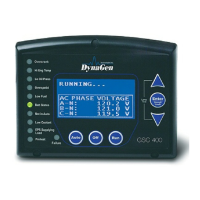32 of 44
User Manual for the GSC400 Programmer and PC Interface
R
sender
= V
sender
* R
pull-up
/ (5 – V
sender
)
3.5.2 Using the Create Sender Table Feature
This section will explain how to create a sender table from pairs of resistance and
value data. Reference Figure 42 below as you go along.
Note: You will need at least 5 data pairs of (resistance, value). The maximum
number of pairs you can enter is 17. The greater the number of pairs the more
accurate the final result will be.
1. Click on the tab of the sender type you want to create a table for (Sender
Type Tab in Figure 36).
2. If you want to modify an existing sender table, select the sender table
from the list (in the Sender Display Area in Figure 36), right click on the
selected sender table, and select one of the three options that appear.
If you are creating a new sender table uncheck the checkboxes [3] for
which you are not going to enter data for. The first five are locked
because you need a minimum of 5 data pairs. The button [2] above the
checkboxes toggles between un-checking or checking all textboxes.
3. If you are creating a new sender table, enter the resistance values in the
resistance boxes [1] and the values in the value boxes [8]. They do not
have to be in order. The resistance and values must be in whole
numbers (no fractions or decimals).
If you need to clear the table and start over click the Clear Table button
[9].
4. Enter the name of the sender that you want to appear in the list of sender
tables in the Name box [4].
5. Enter the name of the sender that you want to appear in the GSC400
front panel menu in the Controller Name box [5].
6. Select the units of the values you entered in the value boxes [8] using the
Select Unit dropdown box [6].
7. Select the impedance type of the sender using the Select Resistance
dropdown box [7]. Select “Low” for senders with a maximum resistance

